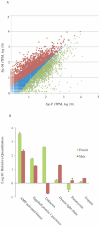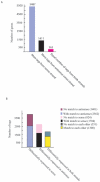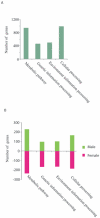Global expression analysis revealed novel gender-specific gene expression features in the blood fluke parasite Schistosoma japonicum
- PMID: 21494327
- PMCID: PMC3071802
- DOI: 10.1371/journal.pone.0018267
Global expression analysis revealed novel gender-specific gene expression features in the blood fluke parasite Schistosoma japonicum
Abstract
Background: Schistosoma japonicum is one of the remarkable Platyhelminths that are endemic in China and Southeast Asian countries. The parasite is dioecious and can reside inside the host for many years. Rapid reproduction by producing large number of eggs and count-react host anti-parasite responses are the strategies that benefit long term survival of the parasite. Praziquantel is currently the only drug that is effective against the worms. Development of novel antiparasite reagents and immune-prevention measures rely on the deciphering of parasite biology. The decoding of the genomic sequence of the parasite has made it possible to dissect the functions of genes that govern the development of the parasite. In this study, the polyadenylated transcripts from male and female S. japonicum were isolated for deep sequencing and the sequences were systematically analysed.
Results: First, the number of genes actively expressed in the two sexes of S. japonicum was similar, but around 50% of genes were biased to either male or female in expression. Secondly, it was, at the first time, found that more than 50% of the coding region of the genome was transcribed from both strands. Among them, 65% of the genes had sense and their cognate antisense transcripts co-expressed, whereas 35% had inverse relationship between sense and antisense transcript abundance. Further, based on gene ontological analysis, more than 2,000 genes were functionally categorized and biological pathways that are differentially functional in male or female parasites were elucidated.
Conclusions: Male and female schistosomal parasites differ in gene expression patterns, many metabolic and biological pathways have been identified in this study and genes differentially expressed in gender specific manner were presented. Importantly, more than 50% of the coding regions of the S. japonicum genome transcribed from both strands, antisense RNA-mediated gene regulation might play a critical role in the parasite biology.
Conflict of interest statement
Figures





Similar articles
-
Identification and characterization of microRNAs and endogenous siRNAs in Schistosoma japonicum.BMC Genomics. 2010 Jan 21;11:55. doi: 10.1186/1471-2164-11-55. BMC Genomics. 2010. PMID: 20092619 Free PMC article.
-
Genome-wide transcriptome analysis shows extensive alternative RNA splicing in the zoonotic parasite Schistosoma japonicum.BMC Genomics. 2014 Aug 26;15(1):715. doi: 10.1186/1471-2164-15-715. BMC Genomics. 2014. PMID: 25156522 Free PMC article.
-
Reverse transcriptase activity and untranslated region sharing of a new RTE-like, non-long terminal repeat retrotransposon from the human blood fluke, Schistosoma japonicum.Int J Parasitol. 2002 Aug;32(9):1163-74. doi: 10.1016/s0020-7519(02)00063-2. Int J Parasitol. 2002. PMID: 12117499
-
Genome-wide identification of Schistosoma japonicum microRNAs using a deep-sequencing approach.PLoS One. 2009 Dec 8;4(12):e8206. doi: 10.1371/journal.pone.0008206. PLoS One. 2009. PMID: 19997615 Free PMC article.
-
In vitro cultivation of Schistosoma japonicum-parasites and cells.Biotechnol Adv. 2013 Dec;31(8):1722-37. doi: 10.1016/j.biotechadv.2013.09.003. Epub 2013 Sep 24. Biotechnol Adv. 2013. PMID: 24070875 Review.
Cited by
-
MicroRNAs Are Involved in the Regulation of Ovary Development in the Pathogenic Blood Fluke Schistosoma japonicum.PLoS Pathog. 2016 Feb 12;12(2):e1005423. doi: 10.1371/journal.ppat.1005423. eCollection 2016 Feb. PLoS Pathog. 2016. PMID: 26871705 Free PMC article.
-
Dynamic transcriptomes identify biogenic amines and insect-like hormonal regulation for mediating reproduction in Schistosoma japonicum.Nat Commun. 2017 Mar 13;8:14693. doi: 10.1038/ncomms14693. Nat Commun. 2017. PMID: 28287085 Free PMC article.
-
A novel Schistosoma japonicum endonuclease homologous to DNase II.BMC Genomics. 2015 Feb 25;16(1):126. doi: 10.1186/s12864-015-1319-5. BMC Genomics. 2015. PMID: 25766859 Free PMC article.
-
Peptides Derived of Kunitz-Type Serine Protease Inhibitor as Potential Vaccine Against Experimental Schistosomiasis.Front Immunol. 2019 Nov 1;10:2498. doi: 10.3389/fimmu.2019.02498. eCollection 2019. Front Immunol. 2019. PMID: 31736947 Free PMC article.
-
Insights into the functional biology of schistosomes.Parasit Vectors. 2011 Oct 20;4:203. doi: 10.1186/1756-3305-4-203. Parasit Vectors. 2011. PMID: 22013990 Free PMC article.
References
-
- King CH, Dickman K, Tisch DJ. Reassessment of the cost of chronic helmintic infection: a meta-analysis of disability-related outcomes in endemic schistosomiasis. Lancet. 2005;365:1561–1569. - PubMed
-
- Webster JP, Oliviera G, Rollinson D, Gower CM. Schistosome genomes: a wealth of information. Trends Parasitol. 2010;26:103–106. - PubMed
Publication types
MeSH terms
LinkOut - more resources
Full Text Sources
Molecular Biology Databases

